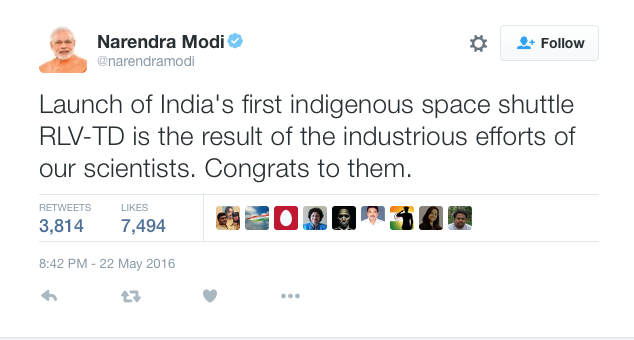
|
| People watch as India's Geosynchronous Satellite Launch Vehicle blasts off carrying a GSAT-6 communication satellite from the Satish Dhawan space center at Sriharikota, India in August 2015. India's space agency said Monday it had launched a minature prototype of a reusable rocket into space from Sriharikota on Monday morning, a milestone as it focuses on reusable space craft. (Stringer/Reuters) |
India successfully launched a miniature shuttle to the edge of space on Monday, a key milestone in its low-cost space program as it turns its focus to building reusable space craft.
The unmanned prototype of the Reusable Launch Vehicle (RLV-TD) launched from the Satish Dhawan Space Centre in Sriharikota, reaching an altitude of 43 miles before returning to Earth, the BBC reports.
The flight, which India's space agency, the Indian Space Research Organization, announced as a success Monday morning, is one of several recent achievements for the program, which has been locked in a race against China, Japan, Vietnam, and North and South Korea for primacy in what some have described as a growing Asian space race.
In 2014, its Mangalyaan spacecraft entered Mars' orbit, making India the first Asian country to reach Mars. It joined the US, Russia, and the European Space Agency as the only countries that have successfully orbited or landed a craft on the Red Planet.
But India also set it itself apart from those deep-pocketed programs by becoming the first to successfully reach Mars on its first attempt — and the cheapest. The orbiter cost a reported $74 million, less than the budget of the Hollywood sci-fi blockbuster "Gravity," as Prime Minister Narendra Modi quipped at the time.
India's program has particularly thrived by keeping costs down. The seven-foot (23 meter) RLV-TD that launched on Monday cost only $14 million to produce, tech site The Verge reports.
The space agency has also emphasized using smaller rockets and keeping the weight of its spacecraft low to use less fuel. The payload of the Mangalyaan orbiter, for example, was just 33 pounds, the Christian Science Monitor reported in 2014.
Mid-level engineers and managers at the ISRO draw comparatively low salaries, about $1,600 a month, while space agency has also conducted fewer ground tests, which can often be expensive.
On Monday, Mr. Modi applauded the effort on Twitter:

|
Creating a reusable space craft has also become a market of its own, with efforts underway from NASA, the ESA, and Russia, in addition to private efforts backed by Amazon founder Jeff Bezos's Blue Origin and Tesla head Elon Musk's Space X.
India's RLV-TD prototype was in development for more than a decade, while the ISRO plans to use the data from the small craft's launch on autonomous navigation, hypersonic speed, and the re-entry process to launch a larger craft within the next ten years.
With the launch of a lunar probe in 2008, the space agency began moving away from its original vision, laid out by founder Vikram Sarabhai in the 1960s, to reject "the fantasy of competing with economically advanced countries" and focus on improving the lives of ordinary people.
The ISRO had focused on launched a large network of communications satellites, but increasingly began moving towards space exploration. The Mangalyaan launch, which was eagerly watched by schoolchildren around the country, was particularly focused on monitoring Mars for traces of methane, a gas that could possibly indicate signs of life on the Red Planet.
Officials have shied away from describing its efforts as a "space race" with other Asian nations, particularly China, which has formed its own regional space agency, the Asia Pacific Space Cooperation Organization, which includes Bangladesh, Thailand, and Mongolia as dues-paying members, the Daily Beast reports.
But Modi framed the program in more sweeping terms in a 2014 speech following the launch of a rocket carrying satellites from France, Singapore, Germany, and Canada.
"This fills every Indian's heart with pride and I can see it reflected in the joy and satisfaction on your faces," he said from the launch site on India's southeastern coast, Reuters reported. "Truly this is a global endorsement of India's space capability."
Page created on 5/23/2016 5:53:49 PM
Last edited 5/23/2016 5:53:49 PM


